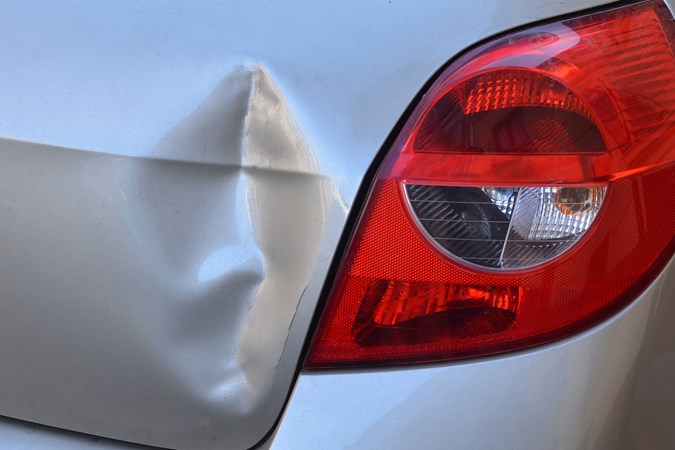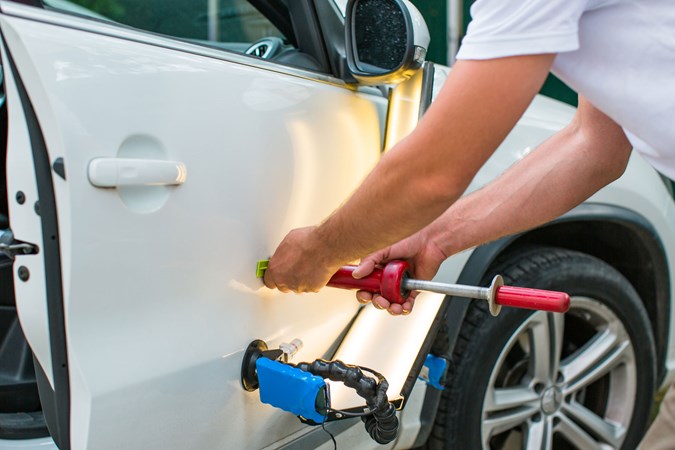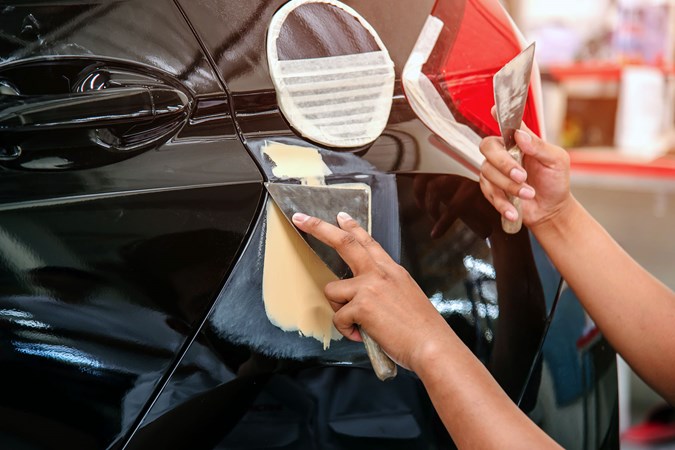You know how it is – you come back from a day’s shopping only to see you car’s received an annoying fresh prang. Obviously, there’s no note under your wiper, so it’s up to you to fix it – but first you need to learn how to remove small dents from your car. Fortunately, if you don’t want to spend any money and even if you only have a few basic tools to hand, you can often reduce or remove small dents with some care and patience.
We understand. Bodywork isn’t for everyone, as it’s often easy to inadvertently make a car look worse. However, if you’d like to have a go then read on for some ways to get started with car dent removal. If you’re not confident, though, it’s best to leave this job to professionals – because professional dent removal by a smart repair specialist tends to be comparatively inexpensive, quick, and the results are excellent.
Read on to check out the different methods for getting a dent out of a car at home, along with what you’ll need and how to do it.
What kind of dents can I fix at home?
Firstly, it’s best to only tackle dents that are on flat or smooth areas of the bodywork. If the dent is on a crease, curve or otherwise complicated area of the bodywork, it’s probably best to leave fixing it to a professional.
Smaller dents are also often easier to fix than larger ones, because there’s less chance of ending up with an obvious flaw in a panel if your repair doesn’t go very well – and you might also cause problems elsewhere in the process. However, if it’s a car you aren’t hugely fussed about, you could improve the way it looks with a basic repair.

You can tackle dents in steel, aluminium and plastic panels at home, too, but aluminium tends to be more difficult to work with – so, again, consider whether you really want to have a go at it, as you could make the issue worse.
If you’re not sure what a panel’s made from, then try sticking a magnet to it; if the magnet sticks and stays on the car easily, it’s a steel panel. If the magnet doesn’t stick but the panel feels and sounds metallic, it’s probably aluminium. If the magnet doesn’t stick but the panel sounds plastic when tapped, and flexes when pushed, it’s probably moulded plastic of some form.
What tools do I need to repair a dent in my car?
This depends on how you want to tackle the dent. If you just want to have a go at car dent removal and aren’t hugely fussed at the quality of the outcome – say, you’ve got an old car that you just want to make a little bit smarter – then you can get away with just a few simple tools that you’ve probably got in the garage. A few blocks of wood and a rubber mallet, or a plunger, for example, could be all you need.

If you want to neatly remove a dent, you’ll probably want and need to invest in some dent removal tools. You can often pick up tools that’ll make the job at hand easier for between £10-£20, such as a basic car dent puller, but more involved dent repair will probably necessitate a car dent repair kit that’ll set you back between £30-£100. These usually include a puller and a glue gun, for adhering the puller to the bodywork, as well as other small tools.
Some you’ll find online are of a poor quality, though, so do some research or be prepared for a bit of faff. Unsurprisingly, professional-grade tools cost a lot more and, at that point, you’d probably just be better off paying to have the job done by someone else.
How to get a dent out of a car
There are several different ways you can remove dents at home, ranging from using basic garage tools to professional car dent removers. If you’re happy with tackling the dent and it’s in an easily accessed and repairable spot, here’s what you could use to fix it.
1. Push out the dent

If you can get behind the dent, you may be able to pop it out by pushing on it or levering against it. The effectiveness of this method varies with the severity of the dent and the strength of the material, though. You can also try using a small ball-peen hammer, with a rounded head; put a block of wood on the outside of the dent, the visible part, and hold it against the panel while you tap the dent out with the hammer from behind. Be careful not to make the dent proud, though, so start off gently.
This might not allow you to completely remove the dent or the surface imperfections, but it could greatly reduce the amount of subsequently filling and repairing that’s required. Warming the panel first will also help, so apply some heat to help ease the process. Just bear in mind that too much heat can damage the paintwork. Go easy with the heat gun and warm the area up gently. The only downside is that in, many cases, getting behind the dent will involve removing interior trim components.
2. Use a plunger, suction cup or vacuum

One of the quick-and-easy suction-based dent fixing approaches is to use a plunger. You simply put the plunger on the dented area and push and pull to try and get the dent to pop out, leaving a comparatively unmarked panel. Remember to clean the panel and plunger first, though, and wet the plunger to make it adhere to the panel more consistently.
You can also buy small suction cups that you could try to use for dent removal. These dent pullers are relatively inexpensive and can help you get small dents out easily. You can combine them with some heat, which can make the panel more malleable to work and allows the dent to pop out more easily.
Alternatively, if you’ve more time, you could try using a vacuum cleaner. The idea is to use the suction from the vacuum to pull the dent out of the panel. You shouldn’t just put the vacuum’s nozzle against the panel, though, as it could damage it; instead, cut a hole in a bucket or pot, then use bodywork-friendly tape to secure the improvised suction chamber over the dent. Then, place the vacuum’s nozzle over the hole and switch the vacuum on, drawing the air – and hopefully the dent – out.
3. Use a dent-pulling slide hammer

You can buy dent-puller kits that have suction cups, a slide hammer and a variety of other attachments for not a great deal. You put the suction cup on the dent, attach the slide hammer to the cup, and then use the hammer action to pull the dent out. It’s a little like using a plunger, but costs more and can have better results, especially on thicker panels.
It’s often not a gentle process but it can allow you to quickly and comparatively easily pull a dent out of a panel. More expensive versions are available as well, which include vacuum pumps to create improved suction that allows the tool to get a better grip on the panel.
Either type will often include hooks or other attachments which will allow you to have a go at fixing dents on the edge of panels or in harder-to-access areas. Again, as with this and the other methods, remember to apply some heat to make the metal or plastic easier to work.
4. Use heat and rapid cooling

If you’ve got a dent in a plastic bumper, you can sometimes easily remove it by pouring boiling water over it to make it more flexible, and then pop the dent out from behind. Cool it off afterwards and the job is done.
You can use temperature change to remove dents in both plastic and metal surfaces, too. Start by heating the dent with a hair drier, holding it at a sensible distance as to avoid damaging the paint. Once it’s hot, use a can of compressed air to spray the dent. This will rapidly cool the panel, causing it to contract and pop the dent out. You can also try using chilled water on the panel if you don’t have compressed air to hand.
5. Using hot glue and wooden dowels
You can create your own inexpensive dent puller using wooden dowels, some screws and a glue gun. Firstly, test the glue gun and glue on an inconspicuous area of your car’s bodywork and make sure you can remove it easily with, say, some rubbing alcohol from a dropper bottle. A small amount applied to the glue should allow you to easily pull the hot glue off the panel without damaging the paint.
Afterwards, make a T-shaped handle or two out of a section of dowel and some screws. Use the hot glue gun to affix the dowels to or around the dented area and, once the glue has dried, use the dowels to manipulate and pull on the dent. Once done, you can use a hair drier or heat gun to release the glue. Afterwards, use rubbing alcohol or similar to quickly clean up the glue, then wipe the panel down and polish it up. Be very careful, though, as it’s easy to damage the paint with glue-removing chemicals such as acetone.
6. Using a repair kit with a dent lifter

A more professional approach to using hot glue and wooden dowels is to use a kit that includes a dent lifter or puller. These small tools have a pedestal and a lifting head, the latter of which you glue to the dent. The lifter then allows you to pull the dent upwards, while the pedestal pushes against the bodywork, hopefully pulling the dent out without causing further damage.
You can usually get inexpensive kits online and these will include various additional tools, pulling heads, glue and glue removal alcohol.
7. Fill in the dent and paint over it

If you can’t get the dent out, or you’ve managed to get it out but there’s still an imperfection in the panel, you could fill it in. Automotive body filler kits and paint touch-up kits are comparatively inexpensive and easy to use but some care and time will be required, especially when it comes to preparation and painting. The bigger the dent, though, the harder and more involved this job will be, especially if you want a decent result.
How much to remove a small dent from a car?
How long is a piece of string? It would be understandable if you want to hire a professional dent remover, given how easy it is to inadvertently make cosmetic damage look worse. Fortunately, paintless dent removal services – reshaping the panel without having to repaint it – are common and you should be able to easily find a mobile smart repair service that can come to your house and fix your car.

These services often don’t charge a tremendous amount for professional dent repair, either, but what you need to pay will vary significantly depending on the dent and its location. The service you choose will be able to provide a quote, however, so you’ll have some idea as to what the final figure should be. A rough and ready guide would be around £100 per panel for a repair.
FAQs
Does boiling water pop out dents?
Yes, boiling water can pop out dents on your car depending on the severity of the damage, and is a popular DIY method on plastic bumpers. Ultimately, it can be a quick and temporary fix for small dents, although it’s not likely to be effective on all materials. If you’re faced with severely damaged metal panels, we would recommend professional dent removal services.
What kind of dents can be popped out?
There is an array of terminology out there to describe damage to vehicle’s paint, bumper, body and panels. But in simple terms a ‘ding’ is a smaller, less significant piece of damage and can be fixed through simple DIY, like using a small suction cup or applying heat. However, a dent is more severe and may involve damage to the car’s paint and body panels.
The type and location of a dent will determine whether you can pop it out at home or if you need professional help. For example, a round dent (circular indentation) can be popped back out without professional help required, using various techniques outlined above.
Just so you know, we may receive a commission or other compensation from the links on this website - read why you should trust us.






















